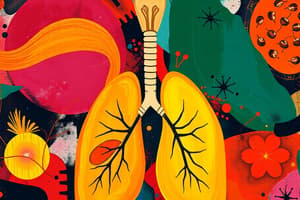Podcast
Questions and Answers
Where does cellular respiration primarily occur in eukaryotic cells?
Where does cellular respiration primarily occur in eukaryotic cells?
- Cytoplasm
- Mitochondria (correct)
- Nucleus
- Endoplasmic Reticulum
Which of the following is NOT a stage of cellular respiration?
Which of the following is NOT a stage of cellular respiration?
- Krebs Cycle
- Oxidative Phosphorylation
- Photosynthesis (correct)
- Glycolysis
Which of the following is a byproduct of cellular respiration?
Which of the following is a byproduct of cellular respiration?
- Glucose
- Carbon Dioxide (correct)
- Oxygen
- Water
Which of the following is responsible for expanding and contracting during breathing in mammals?
Which of the following is responsible for expanding and contracting during breathing in mammals?
Anaerobic respiration is characterized by the absence of which gas?
Anaerobic respiration is characterized by the absence of which gas?
In which organ does gas exchange primarily occur in mammals?
In which organ does gas exchange primarily occur in mammals?
Which type of respiration does not require free oxygen?
Which type of respiration does not require free oxygen?
How do fish primarily acquire oxygen?
How do fish primarily acquire oxygen?
Which organisms require more sophisticated systems for gas exchange?
Which organisms require more sophisticated systems for gas exchange?
What is the primary function of gills in fish?
What is the primary function of gills in fish?
In which environment is anaerobic respiration common?
In which environment is anaerobic respiration common?
Which type of respiration produces a higher yield of ATP?
Which type of respiration produces a higher yield of ATP?
Flashcards are hidden until you start studying
Study Notes
Respiration in Organisms
Respiration is a fundamental process shared by all living beings; it's how cells obtain energy from nutrients through chemical reactions using oxygen. In this article, we will delve into various aspects of respiration within organisms, including cellular processes, breathing mechanics, and distinct types of respiration.
Cellular Respiration
Cellular respiration occurs inside specialized structures called mitochondria — dubbed the powerhouse of cells. This process breaks down organic molecules like glucose into smaller compounds such as carbon dioxide and water, releasing a substantial amount of stored energy in the form of ATP (adenosine triphosphate). There are three main stages of cellular respiration: glycolysis, citric acid cycle (also known as Krebs cycle), and oxidative phosphorylation. Glycolysis takes place both outside and inside mitochondria, while the latter two stages occur exclusively within them.
Breathing Mechanisms
Breathing—or gas exchange—involves removing waste products (such as carbon dioxide) and obtaining life-sustaining oxygen via specialized organs. Mammals breathe with lungs located within their thoracic cavity, which expands and contracts rhythmically during the process of inspiration (breathing in) and expiration (exhaling). Major components of the mammalian respiratory system include the nose, trachea, bronchi, bronchioles, alveoli, diaphragm, pleura, and intercostal muscles. Other animals have adapted unique methods, some employing gills instead of lungs for aquatic environments, while others utilize book lungs found in insect larvae or other unconventional solutions depending on their habitat requirements.
Respiratory System Overview
The respiratory system has evolved significantly among different groups of organisms. For instance, plants rely on diffusion across porous surfaces to exchange gases between air and internal tissues. Conversely, multicellular animals require more sophisticated systems to facilitate efficient gas exchange. Fish lack lungs; they acquire oxygen directly from water through specialized gill structures covering their gill arches.
Anaerobic and Aerobic Respiration
Organisms can gain energy through two primary types of respiration based on whether they rely on the presence of oxygen or its absence.
Anaerobic respiration does not require free oxygen and produces far less ATP per unit time compared to aerobic respiration. It involves processes such as fermentation and is common under extreme conditions where limited oxygen exists, such as deep sea floor sediments or muscle tissue during intense physical activity when blood flow temporarily decreases.
On the other hand, aerobic respiration utilizes molecular oxygen as a terminal electron acceptor and generates a much higher yield of ATP through the complete breakdown of glucose. As our discussion thus far indicates, most life forms engage primarily in aerobic respiration, especially those most familiar to us—animals, fungi, and plants.
Understanding these essential biological processes provides valuable insights into the inner workings of life itself and helps illuminate adaptations shaping diverse species throughout history.
Studying That Suits You
Use AI to generate personalized quizzes and flashcards to suit your learning preferences.




